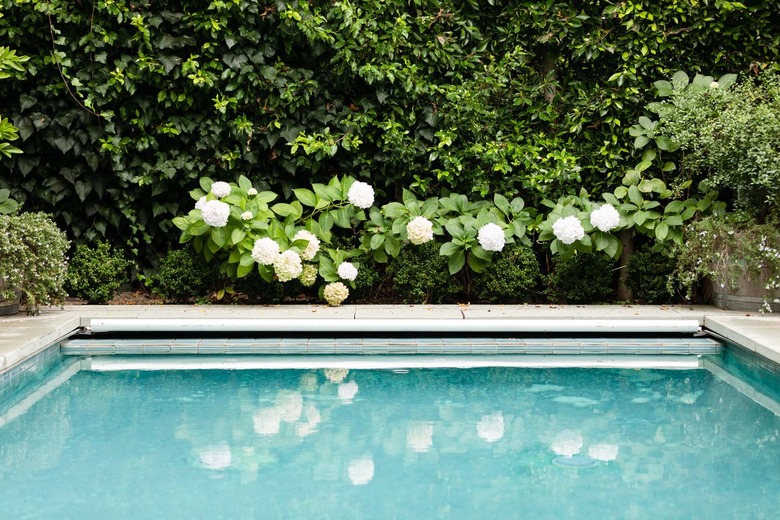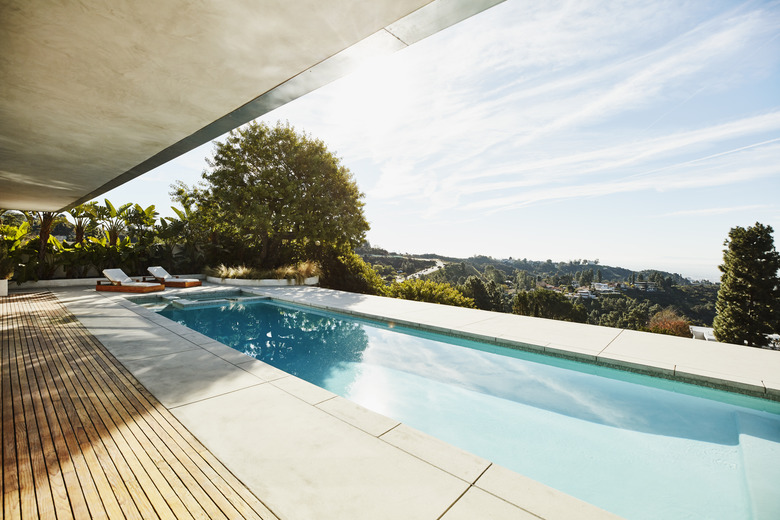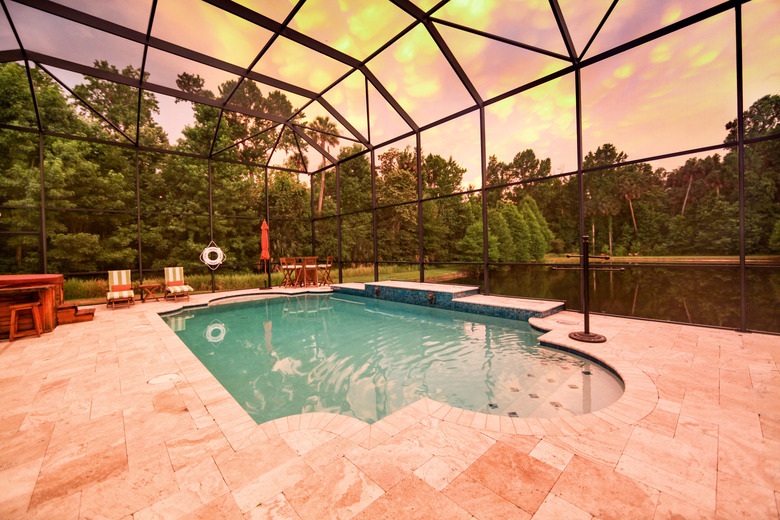A Homeowner's Guide To Swimming Pool Parts
We may receive a commission on purchases made from links.
Upkeep on your swimming pool means more than just removing floating debris and adjusting chemical balance. Both in-ground and above-ground pools rely on essential parts that are crucial to maintaining optimal pool water conditions. A failure with any such part, from the skimmer to the pump, filter or drain, could cause problems for other pool parts and for the overall health of the water.
Suction, Filtration and Return Systems
Suction, Filtration and Return Systems
The typical in-ground pool has several systems that keep it in optimal condition, while above-ground pools are sometimes less elaborate. For an in-ground pool, the suction or water outlet system includes the skimmer and main drains as well as the suction line. These all work together as a water circulation system that filters the water from the pool, eventually recirculating it back into the pool.
The filtration system filters out tiny particles in the water. Since the same water stays in the pool all season long for the most part, the filter is one of the most important pool parts when it comes to keeping the water as clean as possible.
Finally, the return system includes the parts that circulate the filtered water back into the pool. Several return ports are included in an average pool at places designed to maximize water circulation. In some pools, these return outlets or jets can be rotated to point the cleaned water in any direction desired.
Swimming Pool Skimmers
Swimming Pool Skimmers
The term "skimmer" is a bit confusing, as many people also use this term for the meshy netlike tool on a long handle that is used primarily to gather floating debris in the swimming pool. The skimmer that's crucial to your in-ground pool is the one built into its sides near the top level of the water. This device with a basket inside catches visible debris such as leaves, twigs and insects that make their way into your pool. Without the skimmer, such objects could lodge themselves in the suction line or make their way to the pool filter or pump, causing a maintenance issue.
Though above-ground pools don't often come with a skimmer, some have a designated spot in the outer shell to add your own skimmer, although this requires accurately cutting through the pool liner for installation. Clip-on skimmers attach to the side of the pool in an easier manner with no modifications required to the pool itself. Floating skimmers are yet another reliable option for an above-ground pool. These connect to the vacuum and prevent it from sucking up large debris.
No matter how many skimmers your pool has, cleaning them frequently is a key part of pool maintenance, especially if your yard is surrounded by trees. Open the skimmer lid and remove the skimmer basket at least once a week and dump any collected debris into the trash. If the skimmer basket itself looks dirty afterward, wash it or wipe it with a sponge and rinse it with water from the garden hose. If you use soap, make sure it all rinses away to avoid turning your pool into a bubble bath.
The Main Drain or Drains
The Main Drain or Drains
The main drain or drains are usually on the floor of an in-ground pool and typically in the deepest area. Most modern in-ground pools have two main drains set several feet apart to prevent suction and blockage issues that could occur with a single main drain. The main drains serve a similar purpose to a skimmer and are crucial to keeping the water temperature and chemical content consistent.
Although it's called a drain, the main purpose of the main drain setup is to circulate water and keep the water clean. The drains are connected to the pipes that send water toward the pump and then to the filter.
The most basic above-ground swimming pools do not include main drains as part of the included gear, although it is possible to install such drains in above-ground pools. The water stays cleaner with main drains in place, so if you plan to keep your above-ground pool intact for some time, it's easiest to add the drains when the ground is prepared for pool installation. Installing drains for an existing above-ground pool is a lot more work since the drains require digging a trench below the pool's lowest level to install the plumbing for the drains.
Suction Lines and the Pump
Suction Lines and the Pump
The suction lines are pipes or tubes that carry water from the skimmers and main drains toward the pump thanks to the pump's suctioning power. As the name implies, the suction lines have a suctioning action on the water in the pool. This is how a lot of floating debris eventually finds its way into the skimmer area.
Pool circulation pumps use centrifugal force as the pump motor spins an impeller, which looks similar to blades on a fan. As the water travels over the impeller, the spinning action creates vacuum force that draws water from the suction lines, through the pump and on toward the filter. The skimmer basket as well as any auxiliary hair or debris traps on the pump itself must be in place to ensure proper pump operation; otherwise, these could impede the impeller and cause pump failure.
Over time, seals on the pump and motor assembly may crack or weaken, resulting in less effective operation. Replacing the seals is sometimes necessary. If the pump motor fails, it may need to be replaced as well. Whether you have an in-ground or above-ground pool, pool maintenance includes ensuring the pump stays in good working condition.
The Pool Filter
The Pool Filter
The pool filter is next in line after the pump, and its job is to remove small bits of dirt and other debris from the water in both above-ground and in-ground pools. Filters may be a cartridge, a sand filter or a diatomaceous earth filter. The filters are rated in micron indicating the size of the particles the filter catches; this is similar to how a window screen has much smaller holes than hardware cloth, preventing smaller debris from passing through. A filter gauge indicates water flow through the filter, which in turn indicates whether the filter is clear or blocked and in need of cleaning or replacement.
A cartridge filter has a pleated form of polyester inside to catch small debris in the water. Maintaining a cartridge filter is as simple as hosing it off once in a while or giving it a more thorough wash with filter-cleaning chemicals as needed. The filter itself lasts a few years before it needs to be replaced. A sand filter uses silica sand or a sand alternative to filter out tiny particles. It costs less up front than a cartridge filter and is less likely to clog. The sand in the filter lasts five years or so before it needs to be replaced.
A diatomaceous earth filter costs the most and filters out the smallest particles. On the other hand, it's a bit trickier to maintain, requiring additional diatomaceous earth powder from time to time. Made from fossilized microscopic creatures called diatoms, this powder could irritate the airways if it is breathed in directly. Rinsing out the filter for cleaning could also clog sewer lines if large clumps of powder build up.
Return Lines and Jets
Return Lines and Jets
The return lines are the tubes or pipes that help return filtered pool water back into the pool. These lines connect to the filter pump and end at the return jets. Most in-ground pools have at least two of these jets placed along the sides of the pool, often on different areas than the skimmers. The amount in an above-ground pool varies. These jets help circulate the water, which also ensures any chemicals added to the water mix in properly.
The best jets can be rotated to point the water entering the pool to travel in specific directions. It's usually best to aim the jets downward to maximize the mixing of returning filtered water with the existing pool water.
References
- Swim University: Everything You Need to Know About Pool Skimmers
- The Pool Butler: Main Drain Safety
- Inyo Pools: Can an Above Ground Pool Have a Main Drain?
- Leslie's Pool Care: How Does a Pool Pump Work?
- Swim University: How to Select the Best Pool Filter
- Prestige Pools & Spas: What Direction Should My Return Jets Face?


